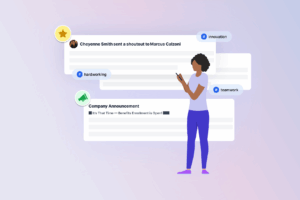Share
As your company grows, an organizational chart (aka org chart) becomes more and more critical. Loose structures help startups adapt and change, but growing companies suffer when employee roles and hierarchies are ambiguous or undefined.
An org chart allows your business to stay organized and agile for change and growth. Discover how org charts should be used by HR and other company leaders within your organization’s internal growth strategy.
What is an org chart?
Many org charts look like a visual map of an employee directory, with key details like names, titles, and contact information for each team member. But they are more than a company phone book.
As the name implies, an org chart visually shows how the workforce is organized. Depending on the size and structure of your business, you might choose one of these common types:
- Hierarchical: draw lines of authority like a pyramid or a family tree
- Matrix: show the web of interconnected teams and collaborators
- Flat: keep it simple for small, egalitarian teams
- Divisional: show the separation between parallel departments
Where do org charts fit into company strategies?
An org chart isn’t just a static reflection of the status quo. Developing your first chart means evaluating the real hierarchies and structure of your workforce. You might identify redundancies and overlapping areas of responsibility. An older company may have legacy policies for oversight and roles that are no longer necessary.
At a minimum, your org chart should clarify structures of authority and responsibility. Who’s in charge of whom? Don’t forget how workflows and niche skills can make subordinates more indispensable than middle management.
Org charts are not an end in themselves, but they’re powerful tools for planning and optimizing throughout the organization, including:
- Staffing
- Budgeting
- Communication
- Hierarchy
- Visualization
How org charts help HR planning + growth
An org chart helps you visualize the workforce as a network of smaller, manageable teams. Not always, but more often than not, large teams are more prone to inefficiency and disorganization. Identify stakeholders without redundancy, as well highlight job functions and responsibilities.
When workers reach out to a new arrival (or someone from a different department), an pictures can help put a name to the right face. As the company continues to grow, HR can use the org chart in new ways. Look for skill gaps and overloaded teams to guide hiring decisions.
Better decision-making
Your growing workforce will keep getting harder to balance and optimize. Which teams need more resources? Where would a new hire (or layoffs) make the biggest difference?
A clear org chart makes it easier to understand team structure and bottlenecks. Make choices that benefit the company without relying on guesswork and subjective opinions.
Plan ahead for hypotheticals
Companies change as they grow, but they also need to stay flexible. How quickly could your company adapt to an essential worker quitting without notice? What about adding a new product line or losing a major source of revenue?
An org chart makes it easier to plan for downsizing or splitting teams. Even without developing official policies, hypothetical scenarios can help you find weak points in your organization.
Better workforce management
Your workers will feel more appreciated when they’re recognized by name. Managers can review names, faces, and roles outside of their immediate circle. HR can use an org chart to inform KPIs as well as set, measure, and track employee goals. Build resilience and redundancy with cross-training and professional development. Conflicts in one department may provide insights for other departments with a similar hierarchy.
Align company-wide goals and performance
Most employees want to feel like their work is meaningful. An org chart clarifies how each individual contributes to the company’s success. Use the chart to visualize the human network of teamwork, responsibility, and accountability. Taking what you’ve learned, use HR technology to empower workers, improving efficiency and collaboration.
Identify high-potential employees
Don’t let personal charisma and subjectivity distract from responsible talent management. An org chart makes it easier for apples-to-apples comparisons between teams and responsibilities, even in different departments. The most friendly and likable managers may not have the most efficient teams, but you’ll need objective data to make those assessments.
Outline growth plans
As the company plans for future growth, an org chart serves as a blueprint for expansion. Do your existing teams have room for additional members, or would it be better to develop talented workers as leaders of new teams?
An org chart makes it easier to judge which types of skills and abilities you’ll need in new hires. Identify gaps in leadership and opportunities for professional development.
Succession planning
According to the BLS, job openings and labor turnover have gone down over the past year. Even in a tight job market, layoffs and discharges (1.6 million in October) are less than half as common as quits (3.6 million).
You can’t control when your key talent might be looking for a new job. Use the org chart to identify potential leaders and successors. Cross-train workers for resilience and stability.
There’s no way to guess whether AI, another pandemic, or worsening recession might have the biggest impact on your company. But it’s a safe bet that your workforce will determine how well your business performs and adapts to whatever’s ahead. Use an org chart to optimize your company’s most important resource: the people who get the work done.
Discover how Netchex can help prepare and guide your organization’s growth with org charts:
Industry news & tips sent straight to your inbox!
Enter your email below to subscribe to industry news, product updates, and tips.
Related articles

Introducing HR Reporting with AI that Can Actually Impact Your Bottom Line

The Real ROI of Streamlining HR and Payroll

Tasks & Workflows: Innovating Automation for HR

